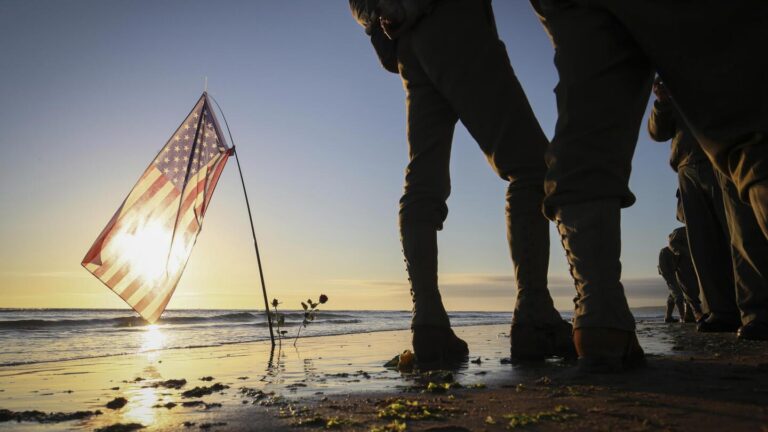COLLEVILLE-SUR-MER, France (AP) — As the sun rises over Omaha Beach, revealing a vast expanse of wet sand stretching to the distant cliffs, the enormity of the task faced by Allied soldiers who landed on Nazi-occupied Normandy beaches on June 6, 1944, begins to sink in.
Several events were held Sunday to mark the 77th anniversary of the Normandy landings, the decisive attack that liberated France and Western Europe from Nazi rule, and to honour those who died.
“These were the men who made it possible for freedom to regain a foothold on the European continent and who, in the days and weeks that followed, walked step by step along the bloody roads from hedgerow to hedgerow of Normandy, threw off the shackles of tyranny,” British ambassador to France Sir Edward Llewellyn said at the unveiling of a new British memorial to the heroes of the Normandy landings.
On D-Day, more than 150,000 Allied soldiers landed on 7,000 ships on beaches code-named Omaha, Utah, Juneau, Sword and Gold. As the sun rose on June 6 this year, exactly 77 years after the dawn invasion, the beaches were vast and nearly deserted.
For the second year in a row, virus-related travel restrictions were imposed on Memorial Day, barring veterans and families of fallen soldiers from the U.S., Britain, Canada and other Allied nations from traveling to France, with exceptions granted for only a few officials.
At the newly erected British Normandy Memorial near the village of Ver-sur-Mer, bagpipes played a tribute and fighter jets flew overhead, trailing plumes of red, white and blue smoke. Socially distanced attendees stood in awe of the majesty and serenity of the site, which offered spectacular and inspiring views of gold beaches and the English Channel.
The new memorial will honour those who died serving under British command during D-Day and the Normandy landings.
An inscription on the wall reads: “They died so that Europe might be free.”
Visitors rose to their feet to salute the more than 22,000 men and women, mostly British soldiers, whose names are inscribed on the stone pillars. Giant screens showed Normandy invasion veterans gathered at Britain’s national memorial and cemetery watching scenes from the battle remotely at the same time. Speaking by video link, Prince Charles said he regretted not being able to attend in person.
On June 6, 1944, “a lightning bolt of freedom flashed in the middle of the fog that covered the Normandy coast,” French Defense Minister Florence Parly said at the ceremony. “France will not forget. France will be forever grateful.”
Charles Shay, a Penobscot Native American who landed as a U.S. Army medic on June 6, 1944 and now calls Normandy home, was the only surviving D-Day veteran from the Vere-sur-Mer ceremony.
Also there was another veteran of the Battle of Normandy, British Captain David Milcrest, who had landed in Normandy with his team on June 12, 1944, to replace officers who had died in the first few days of the battle.
Shea then joined officials from the U.S., Canada, Britain, Germany and other allied nations at a memorial service later in the day at Colleville-sur-Mer American Cemetery, on the cliffs overlooking Omaha Beach.
The cemetery contains 9,380 graves, most of which belong to servicemen who lost their lives during the Normandy landings and subsequent operations, plus 1,557 names inscribed on the Wall of the Missing.
Most public events were canceled and official ceremonies were limited to a small number of selected guests and dignitaries.
Dennis van den Brink, a World War II expert who works in the strategic battlefield town of Carentan near Utah Beach, acknowledged “a great loss, a great absence for all the veterans who couldn’t make the trip.”
“It’s really hard on us because they’re all like 95, 100 years old and we want them to live forever, but, you know…” he said.
“At least we’re keeping the spirit of mourning alive, that’s the most important thing,” he told The Associated Press.
Over the weekend, many locals visited memorials marking key moments of the battle and paid tribute to the soldiers. French WWII history buffs and tourists from neighboring European countries were also seen riding jeeps and military vehicles on the roads of Normandy.
Some re-enactors arrived at Omaha Beach in the early hours of the morning carrying flowers and American flags to pay tribute to those who died that day.
On D-Day, 4,414 Allied soldiers were killed, including 2,501 Americans, and over 5,000 were wounded. Thousands more were killed or wounded on the German side.
Normandy is home to more than 20 military cemeteries, most of which are the resting places of American, German, French, British, Canadian and Polish soldiers who took part in the historic battle.
Senior administration officials stressed the importance of preserving the legacy of the Normandy landings for future generations.
“In the face of today’s threats, we must act together and show unity, so that peace and freedom will follow,” Parly said.
___
Nicolas Garriga contributed to this report from Ver-sur-Mer.
___
An earlier version of this story corrected the British ambassador’s surname to “Llewellyn” rather than “Llewelyn.”


